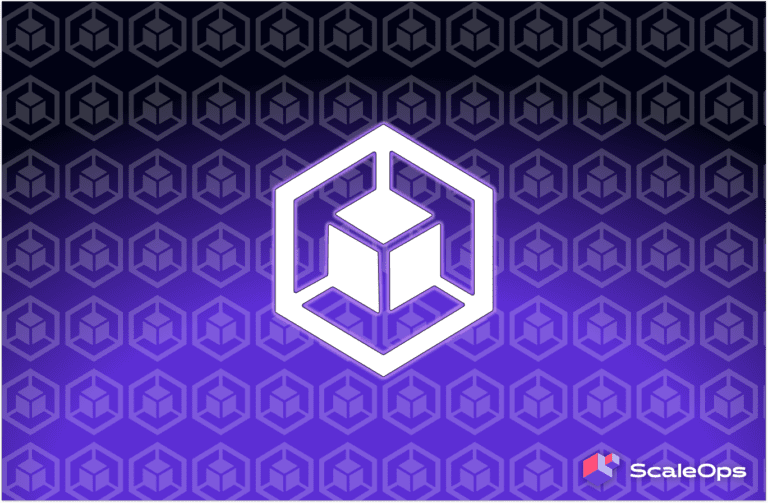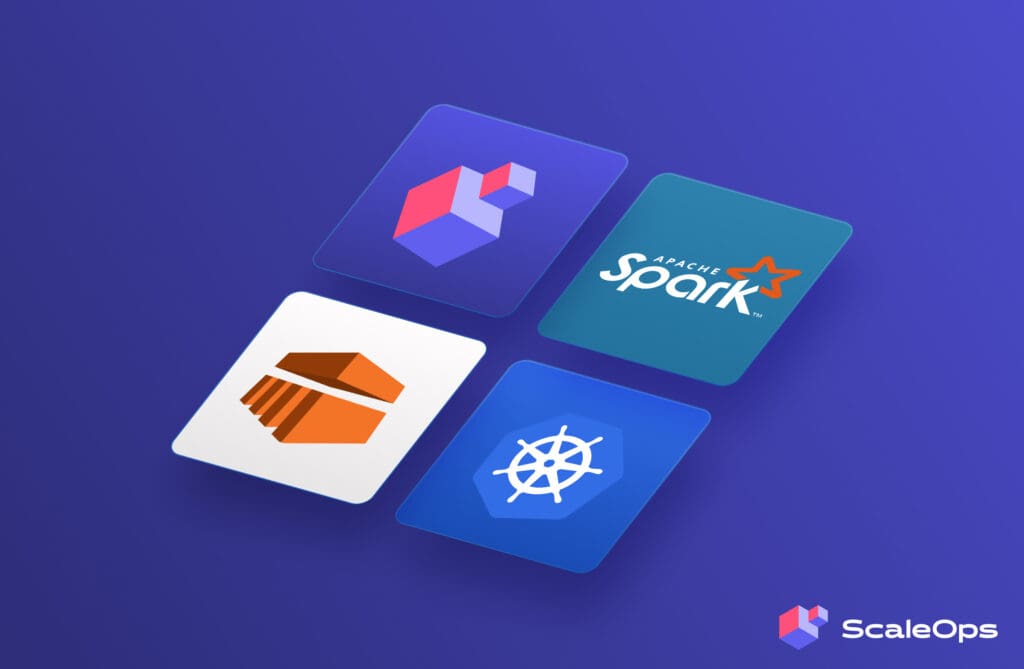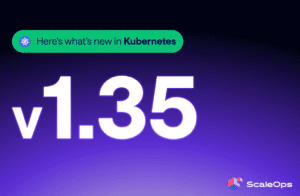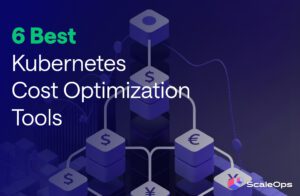Separate stacks are obsolete. Platform teams no longer need to maintain Kubernetes for stateless applications alongside static Hadoop/YARN clusters for Spark workloads. This split is inefficient, leading to rigid resource management and expensive, idle capacity.
Spark on Kubernetes: A Unified Model
Running Spark natively on Kubernetes changes the execution model. Instead of submitting jobs to a YARN ResourceManager, Spark leverages the Kubernetes scheduler directly. This unlocks Dynamic Resource Allocation (DRA), allowing Spark to request and release executors on demand.
For this to work smoothly, shuffle data must persist across executor rescheduling, typically through resilient storage or shuffle tracking. With that in place, executors scale dynamically as pods, sharing cluster capacity alongside your microservices.
It is a shift from cluster-level reservations to pod-level, on-demand consumption. Amazon has embraced this pattern by bringing its battle-tested EMR runtime directly to existing EKS clusters, and similar models are emerging across other cloud platforms.
EMR on EKS and Kubernetes Primitives
EMR on EKS makes this unified model production-ready by mapping Spark concepts to Kubernetes primitives:
- Each virtual cluster maps 1:1 to a Kubernetes namespace. This enables strong multi-tenancy so you can enforce team-level security and limits with native objects like
ResourceQuotasandNetworkPolicies. - Drivers and executors as pods. Each Spark driver and executor runs as its own pod, with jobs containerized to include exactly the libraries they need. Whether based on a shared image or fully custom, this approach eliminates the “dependency hell” of a shared cluster classpath.
- Security managed via IAM Roles for Service Accounts (IRSA). You grant granular, pod-level permissions to AWS resources such as S3, which is more secure than sharing instance profile credentials.
The Spark Resource Tuning Trap
The dynamic, on-demand model is powerful, but it creates a major operational challenge: the manual tuning loop.
For each job, engineers are forced to guess a cascade of Spark configs like spark.executor.memory. When a job is submitted, Spark translates this initial guess into a fixed memory request for the Kubernetes pods that will run the job.
This process is a classic lose-lose situation. Guess too low, and your jobs crash with OOM errors, wasting hours. Guess too high, and you pay for underutilized resources. This traps teams in an endless, reactive cycle of manual adjusting these settings based on gut feeling, not data.
The ScaleOps Platform breaks this cycle by introducing a data-driven feedback mechanism. Developers set an initial resource “guess” once, however ScaleOps then understands actual memory and CPU usage of the pods running that job, and then automatically manages resource requests based on real-world usage, not static assumptions. It transforms the manual tuning loop into a continuous, context-aware optimization cycle, ensuring that every job runs with maximum efficiency and stability.
Beyond Sizing: The Kubernetes Shuffle Challenge
Resource tuning is only half the battle: shuffle handling is the bigger challenge. By default, shuffle data lives on executor disks, so when pods are evicted (common on Spot), jobs can fail. Production setups solve this either by writing shuffle to resilient storage like S3 or by pinning shuffle-heavy jobs to stable On-Demand nodes.
The gap that exists here isn’t Spark, but rather it’s managing these strategies reliably at scale. And this is exactly where a context-aware automation layer becomes essential.
Intelligent Resource Automation for Spark on Kubernetes
ScaleOps delivers the automation layer that makes Spark on Kubernetes practical at scale:
- Automatic workload discovery: ScaleOps works out of the box with no code changes required in your Spark applications. The platform automatically identifies Spark workloads (and any other workload) across deployment models (Spark Operator, spark-submit, EMR on EKS).
- Policy-based automated rightsizing: End the guesswork on resource requests. ScaleOps is application context-aware and ensures that Spark jobs receive the exact resources needed at any given time, eliminating waste and preventing OOM failures so you can maximize savings without sacrificing stability.
- Strategic Spot optimization: Cut costs even more with Spot Optimization. Jobs using resilient shuffle (e.g., S3) can run mostly on Spot, while shuffle-intensive or critical jobs stay 100% On-Demand for stability. ScaleOps gives fine-grained control over Spot targets, fallback, and disruption tolerance, maximizing performance and savings without risking reliability.
- Smart Pod Placement: ScaleOps packs executors tightly onto fewer nodes, reducing waste while respecting affinity, topology, and PDBs so stability isn’t compromised. This results in more efficient placement, predictable scale-down and lower costs.
Beyond EMR: ScaleOps and the Spark Ecosystem
While EMR on EKS is a major use case, ScaleOps provides consistent optimization across your entire Spark ecosystem, recognizing workload patterns regardless of submission method or runtime:
- EMR on EKS: Optimized for AWS’s enhanced runtime and virtual cluster model.
- Native Spark on K8s: Direct integration with Apache Spark’s Kubernetes scheduler.
- Spark Operator: Full support for the popular CNCF Spark Operator.
- Multi-Cloud: Works across EKS, GKE, AKS, and on-premises Kubernetes.
Real-World Impact
Organizations using ScaleOps for Spark on Kubernetes see dramatic improvements across multiple dimensions. Cloud and infrastructure costs drop by up to 80% with real-time, automated workload rightsizing.
Job failures drop dramatically as well since OOM-errors and resource contention become rare occurrences. Teams eliminate time spent on manual Spark configuration entirely and performance and reliability is maximized even as workloads scale and evolve.
The best part? Benefits compound over time as ScaleOps continuously learns about your workload patterns and continues to manage optimization efforts efficiently and automatically.
Getting Started
- Quick and Safe Install
Deploy ScaleOps with a single Helm command.
- Instant Discovery and Visibility
ScaleOps immediately detects all your Spark workloads and automatically assigns the optimal rightsizing policy based on real-time demand and cluster conditions. This eliminates waste, prevents OOM failures, and ensures stable performance.
- Activate Automated Rightsizing
With a single click, activate the first layer of optimization. ScaleOps will continuously rightsize every job based on real-time demand, eliminating waste and preventing OOM failures automatically.
- Maximize Savings with Spot
Once you’ve enabled automatic rightsizing, automate the optimization of Spot instances. ScaleOps automatically detects the best optimization policy (e.g. on-demand, spot-friendly, etc) that maximizes savings without impacting performance or workload availability. Confidently shift workloads to Spot, knowing that ScaleOps is intelligently ensuring placement, fallback, and optimized performance and reliability.
The Future of Kubernetes Spark Resources is Continuous Automation
The convergence of application and analytics infrastructure on Kubernetes is now the standard for organizations seeking operational efficiency. EMR on EKS and native Kubernetes primitives make this consolidation possible, but the real challenge is operational overhead.
Every Spark job still demands precise resource specification, placement strategy, and ongoing tuning, tasks that don’t scale and rarely persist across workloads. This is where automation becomes essential.
ScaleOps closes the gap by continuously managing resource requests with application context-aware intelligence. The result is Spark and microservices running side by side on Kubernetes, efficient, reliable, and fully automated.
See the ScaleOps Platform in action. Book a demo or start your free trial today.























